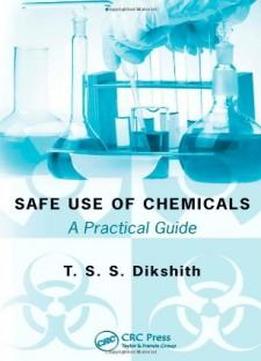
Safe Use Of Chemicals: A Practical Guide
by T.S.S. Dikshith /
2008 / English / PDF
4.8 MB Download
Occupational workers frequently use, store, and dispose of toxic
chemicals without knowing the possible consequences, both for the
workplace and the environment. Improper use or misuse of chemical
substances can result in health disorders, fatalities, or
chemical disasters.
Occupational workers frequently use, store, and dispose of toxic
chemicals without knowing the possible consequences, both for the
workplace and the environment. Improper use or misuse of chemical
substances can result in health disorders, fatalities, or
chemical disasters.Safe Use of Chemicals: A Practical
Guide
Safe Use of Chemicals: A Practical
Guide presents quick and comprehensive instruction to
those who work with potentially dangerous substances and provides
them with the information they need to avoid the hazards
associated with handling these chemicals.
presents quick and comprehensive instruction to
those who work with potentially dangerous substances and provides
them with the information they need to avoid the hazards
associated with handling these chemicals.Extensive Information on Numerous
Substances
Extensive Information on Numerous
Substances
Thoroughly referenced from a wide variety of sources, this book
contains information on industrial solvents, pesticides, metals,
air pollutants, toxic gases and drugs, as well as other
substances. The information presented for each chemical substance
is concise yet thorough and does not require advanced training to
comprehend. For each chemical, the author provides the CAS
number, IUPAC name, molecular formula, synonyms, uses and
exposures, toxicity and health effects, exposure limits, and
methods of proper storage and disposal. Tables and appendices are
included where appropriate.
Thoroughly referenced from a wide variety of sources, this book
contains information on industrial solvents, pesticides, metals,
air pollutants, toxic gases and drugs, as well as other
substances. The information presented for each chemical substance
is concise yet thorough and does not require advanced training to
comprehend. For each chemical, the author provides the CAS
number, IUPAC name, molecular formula, synonyms, uses and
exposures, toxicity and health effects, exposure limits, and
methods of proper storage and disposal. Tables and appendices are
included where appropriate.
T.S.S. Dikshith is a member of the World Health Organization
(WHO) Task Group on Environmental Health Criteria Documents and
the International Program on Chemical Safety and has worked in
several laboratories in the United States, France, Germany, and
Canada. By following the guidelines established in this text,
those who work with chemical substances are able to minimize the
risk of disaster and protect themselves and others from the toxic
effects of the substances they deal with on a daily basis.
T.S.S. Dikshith is a member of the World Health Organization
(WHO) Task Group on Environmental Health Criteria Documents and
the International Program on Chemical Safety and has worked in
several laboratories in the United States, France, Germany, and
Canada. By following the guidelines established in this text,
those who work with chemical substances are able to minimize the
risk of disaster and protect themselves and others from the toxic
effects of the substances they deal with on a daily basis.











